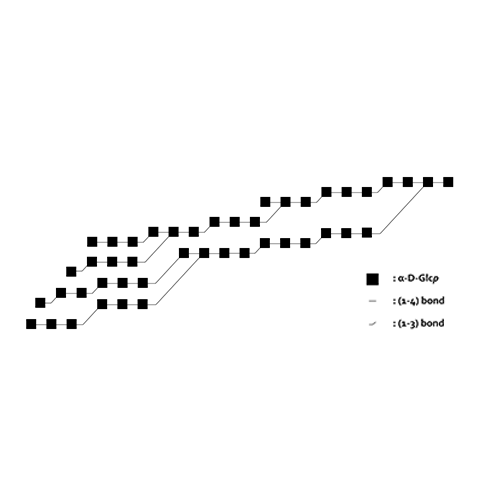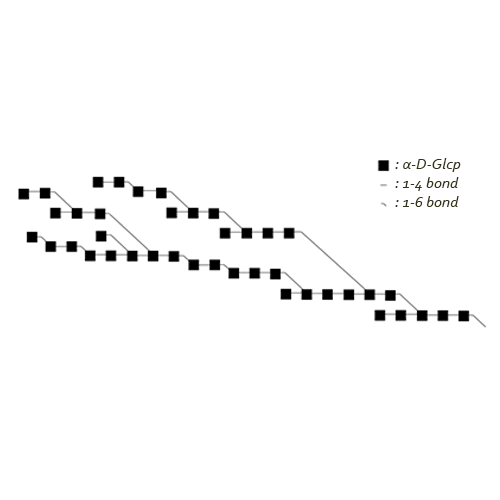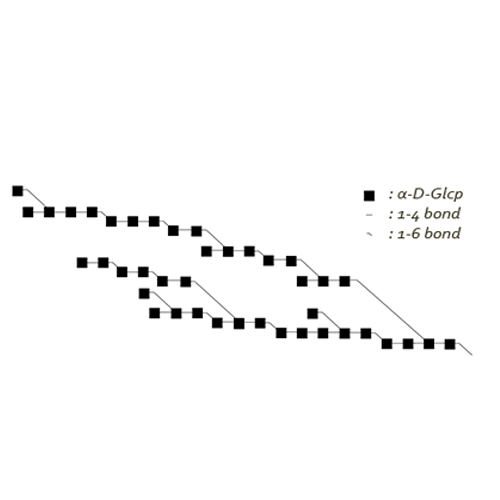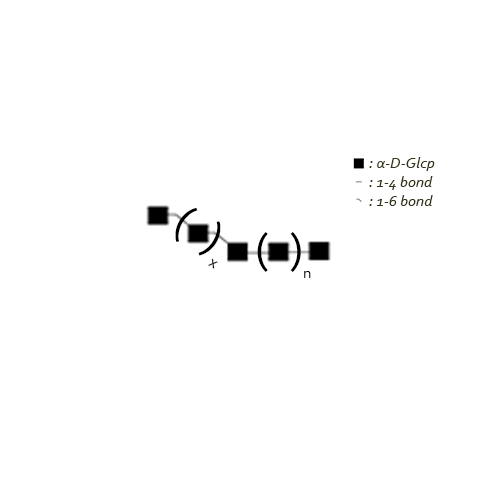-
The N-terminally truncated GtfB enzyme of Lactobacillus reuteri NCC 2613 converts amylose in a low molecular mass (0,007 mDA) reuteran-like polymer. The glucan contains 75 % linear α(1→4) alternated with 25 % α(1→6) glucosidic linkages, and α(1→4,6) branching points. Based on digestibility studies it seems likely that this glucan structure is not or slow digested by the human digestible tract enzymes, so it has a high potential for the food industry.
There are a lot of differences between the products formed by the 4,6 glucanotransferase GtfB subfamily. GtfB strain 121 formes a long linear consecutive polymer with α(1→6) linkages (IMMP), whether the glucan of strain NCC 2613 is branched and has a low molecular weight.
This product is sold for research use only.
-
The GtfD 4,6-α-glucanotransferase enzyme of Paenibacillus beijingensis is a member of the glycoside hydrolase family 70. In the presence of amylose V the enzyme generates two reuteran-like polymers distributions: a high-molecular-mass polymer (HMMP) and a low-molecular-mass polymer (LMMP) containing both long linear α(1→4) chains. The HMM polymer with an average length of 27 MDa contains 71 % α(1→4) and 29 % α(1→6)linkages. While the LMM polymer of 19 KDa consists of 77 % α(1→4) and 23 % α(1→6) linkages. Indicating the HMM has a slightly higher amount of α(1→6) linkages. The polymers may be suitable as a biocatalyst to reduce the glycemic index of starch-containing food.
-
The GtfD enzyme of Azotobacter chroococcum is a unique evolutionary intermediate between glycoside hydrolase family GH13 (α-amylase) and GH70 (glucansucrase). The product of GtfD is a high molecular mass α(1→4,6) branched reuteran like polymer with 68 % α(1→4), and 32 % α(1→6) glycosidic linkages using amylose V as substrate. The polymer has a molecular weight of 13 MDa. The glucan is highly similar to the product formed by Lactobacillus reuteri GtfA glucansucrase from sucrose.
-
The N-terminally- and domain V truncated enzyme GtfB of Lactobacillus reuteri strain 121 converts malto-oligosaccharides and starch in multiple carbohydrate structures. The products formed by the 4,6-glucanotransferase are elongated isomalto-/malto-oligosaccharides (IMMO) and isomalto-/malto-polymers (IMMPs). The enzyme GtfB-ΔN-ΔV converts maltoheptaose with a degree of polymerization (DP) of 7 in linear carbohydrates with DPs ranging from 2 to 35. Size-exclusion chromatography with BioGel P-2 is used to monitor the separated compounds. The glucans of DP > 35 contain 85 % α(1→6), and 15 % α(1→4) glycosidic linkages. Instead, when using amylose V as starting material the product mixture mainly consists of IMMPs. The modified starch products formed by the GtfB enzyme are derived soluble dietary fibers, which are potentially useful in the food industry.
This product is sold for research use only.
-
The GtfC enzyme of Exiguobacterium sibiricum 255-15 is an interesting intermediate between α-amylases GH13 and glucansucrase enzymes GH70. The 4,6 glucanotransferase synthesizes a mixture of isomalto/malto-oligosaccharides (IMMOs) and polymers containing 52 % α(1→6) and 35 % α(1→4)-glycosidic linkages using amylose V. The GtfC enzyme produces significantly more oligosaccharide products compared to the GtfB enzyme of L. reuteri 121.
This product is sold for research use only.





